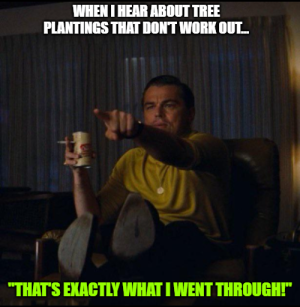People overlook the fact that mankind's intervention (which can be good or bad) has more to do with species composition than anything else. Johnson Grass isn't even native to this country, but it has taken over every hayfield in my area. I thank God that both of my adjoining neighbors who had hayfields have now started cropping. Until they did, I had to go around the fence lines every year and kill the JG that was creeping onto my property. Their gly spraying each year before planting the crops now takes care of the JG bordering me.
My prairie is 85% species that I planted, which did not exist before - not on my farm or any other farm in my area. Unless I quit maintaining it and let briers and trees take over through succession, that composition is not going to change.
Until I planted them, Grey Dogwood, ROD, Arrowwood Viburnum and Witch Hazel did not exist on my farm or the surrounding area. Now these shrubs are popping up everywhere on my land.
80% of the trees planted in my tree planting are species that did not exist on my place or the surrounding area before I planted them. Yet, they are thriving and are the dominant species. Why and how? Because a man (me) intervened.
So, in all of these cases, mankind's intervention has dictated the prominent species composition. All I did was use the common sense things mentioned in my first post above to choose the species to fit the land (and give them the advantage over competition). Nature takes care of the rest.....
On more thing - in a climax forest, the climax tree species that gets the advantage in the beginning is the one that will ultimately prevail. It's the one that gets its head above the others and gets the sunlight. Oaks, sweetgums, yellow poplar, sycamore, etc. are all trees that can be climax species. Give your oaks the advantage in the beginning so that they can get ahead of the others. Once again - mankind's intervention can determine the destiny of the plant composition - including a climax forest.


